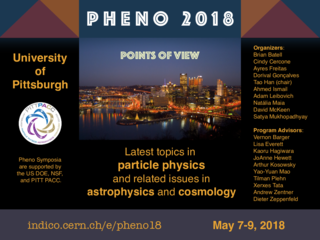The search for associated production of Higgs bosons and top quark-antiquark pairs is reported, based on a dataset of 35.9 fb$^-1$ collected by the CMS experiment in 2016 in proton-proton collisions at a center-of-mass energy of $\sqrt(s)$ = 13 TeV at the CERN LHC. The search expoits statistically independent analysis targeting different Higgs boson and top quark-anitquark pair decay modes,...
The Higgs couplings to heavy quarks, top and bottom quarks, are difficult to directly access experimentally, nevertheless their measurement is crucial for a full characterization of the Higgs sector and to probe a large variety of physics scenarios beyond the Standard Model. In this talk I will discuss the results recently obtained by the ATLAS Collaboration based on Run-2 2015 and 2016 data,...
This talk reviews recent CMS results on the searches for HH pair production at the LHC, in several Higgs decay channels, both resolved and boosted. Several BSM models predict resonances decaying to HH pairs. Non-resonant HH production is not only sensitive to BSM physics but will also eventually inform our understanding of the shape of the Higgs potential of the standard model.
Measuring the Higgs self-coupling at the LHC has proven to be extremely challenging in the Standard Model, making such a measurement a primary target for future 100 TeV colliders. We explore an alternative scenario, where the LHC is upgraded to 27 TeV — the so-called “High-Energy” (HE)-LHC. We demonstrate the capabilities of such a 27 TeV proton collider at measuring the Higgs self-coupling...
With the discovery of Standard Model (SM) Higgs boson at the LHC, exploring the thermal history associated with electroweak symmetry-breaking (EWSB) has taken on heightened interest. In particular, the process of the electroweak phase transition (EWPT) in early Universe provides conditions able to explain the observed cosmic matter-antimatter asymmetry, if the transition were of first order...
The Twin Higgs mechanism can address the naturalness problem without introducing top partners that are produced at hadron colliders with a large cross section. Only the scalar modes and optionally the twin hypercharge gauge boson, but not the remaining partner particles, have direct couplings to the Standard Model states and are therefore the first modes that can be accessed at colliders. We...
The critical point for a Higgs sector is here connected to a minimum in the potential for a modulus field. Dynamics of the modulus set the Higgs mass to zero, making Higgs criticality an attractor. An explicit 5-dimensional model for this type of Higgs sector is constructed, where the modulus field is the radion, and Higgs criticality at the minimum of the radion potential is robust under...

